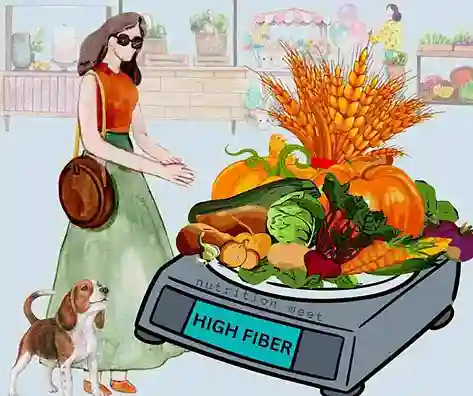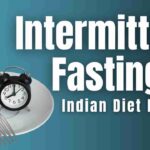The cause of 90% of diseases is overweight and obesity. and looking to the Fiber-rich foods help in weight loss is very obious. Since the extra pound around your waist area or hips or anywhere in your body leads to increased stress on the heart, other vital organs, and the gut. Therefore, losing those extra pounds is extremely important for a healthy lifestyle.
If you have decided to shed extra pounds, then fiber will be your best friend in achieving your dream weight. Read this article to know how and why fiber is important for weight loss, which foods are high in fiber, and overall, besides weight loss, why fiber is good for you.

Table of Contents
What is fiber?
Majorly we talk about carbohydrates being anti-weight loss, but you will be surprised to know fiber also belongs to the class of carbohydrates. Unlike other carbohydrates, our body can’t digest or break down fiber into sugar molecules, thus passing through our body.
The foods high in fiber are generally categorized as ‘good carbs.’ On average, children and adults should consume 25 to 35 grams of fiber daily, of which 6 grams are soluble fiber [1, 4].
Types of Fiber
Sometimes people get confused between the two terms fiber and dietary fiber, however, the primary difference between the two is that fiber is the substance found in plants and dietary fiber is the kind you eat. Mainly, dietary fiber is listed as soluble and insoluble fiber on food labels. Soluble fiber and Insoluble fiber are also two types of fiber we intake [2].
Soluble fiber:
This is the form of fiber that dissolves in water. Mostly, they stay in the digestive system for longer before being absorbed by the body; therefore, it prevents a sudden hike in your blood glucose. On the other hand, Soluble fiber also helps reduce low-density lipoprotein (LDL) cholesterol by flushing them out of the body. Inulin oligofructose, Mucilage, beta-glucans, Polydextrose polyols, Psyllium, Resistant starch, Pectin& gums, and Wheat dextrin are examples of soluble dietary fiber.
Insoluble fiber:
Is unable to dissolve in water or gastrointestinal fluids hence the name insoluble. It passes through the digestive tract without much change and therefore does not provide any calories to the body. Mainly insoluble fiber is important to our body to provide hydration and move waste through the intestine for excretion. Lignin, cellulose, and some hemicellulose are examples of insoluble fiber.

Why fiber is important for weight loss
It has been observed that the intake of vegetables and cereals, foods high in fiber, is linked to reduced weight gain in adults [12]. The higher satiety value compared to other complex carbohydrates and simple sugars consumption of dietary fiber provides lower calories and tends to stay longer; therefore, increasing the duration between two consecutive meals is a major reason for the reduction in weight gain [15].
A plethora of other studies also support the assumption that is increasing the intake of fiber, specifically soluble fibers like beta-glucan and glucomannan, slows down digestion and leads to weight loss. Even a reduction in belly fat is also observed [16, 17, 18]. This may be the reason why all the diet plans let be Ketogenic or vegan, or any planning diet stresses the intake of high fiber.
Health Benefits of fiber consumption
According to clinical studies, intake of dietary fiber and whole grain directly prevent Obesity, type 2 diabetes, cancer, and cardiovascular disease (CVD) [5].
Prevention of cancer:
Many studies claim the inverse relationship between dietary fiber and the development of different types of cancer, such as small intestine, oral, breast, etc. the exact mechanism of how fiber prevents cancer is still unknown. Still, some scholars believe that ability of Dietary fiber to remain undigested in the small intestine and get passed on to the large intestine allows the fermentation of fiber in the large intestine. Short-chain fatty acids are produced upon fermentation, which has anti-carcinogenic properties [7, 8].
Moreover, high fiber in association with gut microflora modulation and production of butyrate prevents large bowel cancer and colon cancer since butyrate can inhibit histone deacetylase in signaling pathways promoting cancer cell apoptosis and regulating immune homeostasis [6].
Prevention of Type 2 diabetes
Studies have always noticed an inverse relationship between dietary fiber and Type 2 diabetes, as fiber supplements reduce fasting blood glucose and HbA1c [10].
According to Davison et al., cereal fibers are more effective as compared to fruit fiber in preventing and controlling Type 2 diabetes since they modulate gut microflora by the mechanisms of improving glucose tolerance, reducing inflammation, and altering immune response [9].
Prevention of Cardiovascular disease
Mainly to improve your cardiometabolic profile, fiber inhibits the absorption of fats and simple carbohydrates, reduces inflammation, reduces reactive oxidation, and improves lipid profile & blood pressure [11].
Prevention of constipation
Since insoluble fiber does not get digested in the gastrointestinal tract, thus travels intact to the colon and acts like a broom to push out the waste by adding bulk and weight to the stool. Nonetheless, consuming an adequate number of high-fiber foods speeds up bowel movement and prevents gastrointestinal blockage and constipation [14].
Conclusion
Fruits & vegetables, cereals, and other fiber supplements are the main sources of fiber. It is categorized into two groups Soluble fiber and insoluble fiber which have tremendous health benefits such as the crucial role in weight loss, prevention of cancer, cardiovascular disease, Type 2 diabetes, constipation, etc. The plethora of research related to dietary fiber has common findings which suggest that for a healthy lifestyle one must consume an adequate amount of fiber throughout their diet.
FAQ
What is the high-fiber diet definition?
The foods can be defined and categorized as high fiber diet if and only if they satisfy or exceeds the Dietary Reference Intake (IOM), which is 14 -25 grams for children between 1 to 13 years and 25 -38 grams for adults [4].
Why can fiber not be digested?
Since, Fiber contains a whole lot of unique blends of bioactive components like resistant starches, vitamins, minerals, phytochemicals, and antioxidants; it cannot be digested by the small intestine and may or may not be fermented in the large intestine [3].
What are the top 10 fiber foods?
1. Three-bean salad, burritos
2. Broccoli
3. Brown rice
4. Almonds
5. Walnuts
6. Bran cereal
7. Berries
8. Avocadoes
9. Oatmeal
What are the top 10 best fiber supplements?
1. Fiber gummies
2. inulin fiber
3. Organic Acacia fiber
4. Hemp husk
5. Psyllium
6. Psyllium husk powder
7. Guar fiber
8. β-glucans fiber
9. Glucomannan
10. dextrin fiber
What are the benefits of fiber?
The fiber can protect you against obesity, type 2 diabetes, cancer, and cardiovascular disease (CVD) [5].
What are the side effects of fiber?
Too many Fiber supplements or increasing your intake of the high level of fiber too quickly in your diet may cause intestinal gas, abdominal bloating, and cramping. It would help if you took extra precautions and must consult a doctor before altering the fiber content in your diet in case of a history of a bowel blockage or Crohn’s disease.
Are eggs high in fiber?
No, Eggs are low-carb food and thus has fewer amount of sugar and no fiber.
How can I increase fiber in my diet?
To increase dietary fiber in the diet, an individual should choose whole grains over refined grains; include fiber supplements like Guar fiber, Psyllium husk, Glucomannan, or β-glucans; Eat chia seeds fiber; eat avocados; snack on nuts and seeds, etc.
Which fiber foods are for adults?
Include high-fiber breakfast and specific cereals such as oats and plain shredded whole grain.
Include foods high in fiber in your diet, i.e., chia seeds, avocados, whole grains, vegetables, nuts, dried or fresh fruits, etc.
Go for potatoes with skin and include a lot of vegetables in your lunch and dinner.
One can also include fiber supplements such as Guar fiber, Psyllium husk fiber, Psyllium fiber, Glucomannan fiber, β-glucans fiber, inulin fiber, or dextrin fiber.





